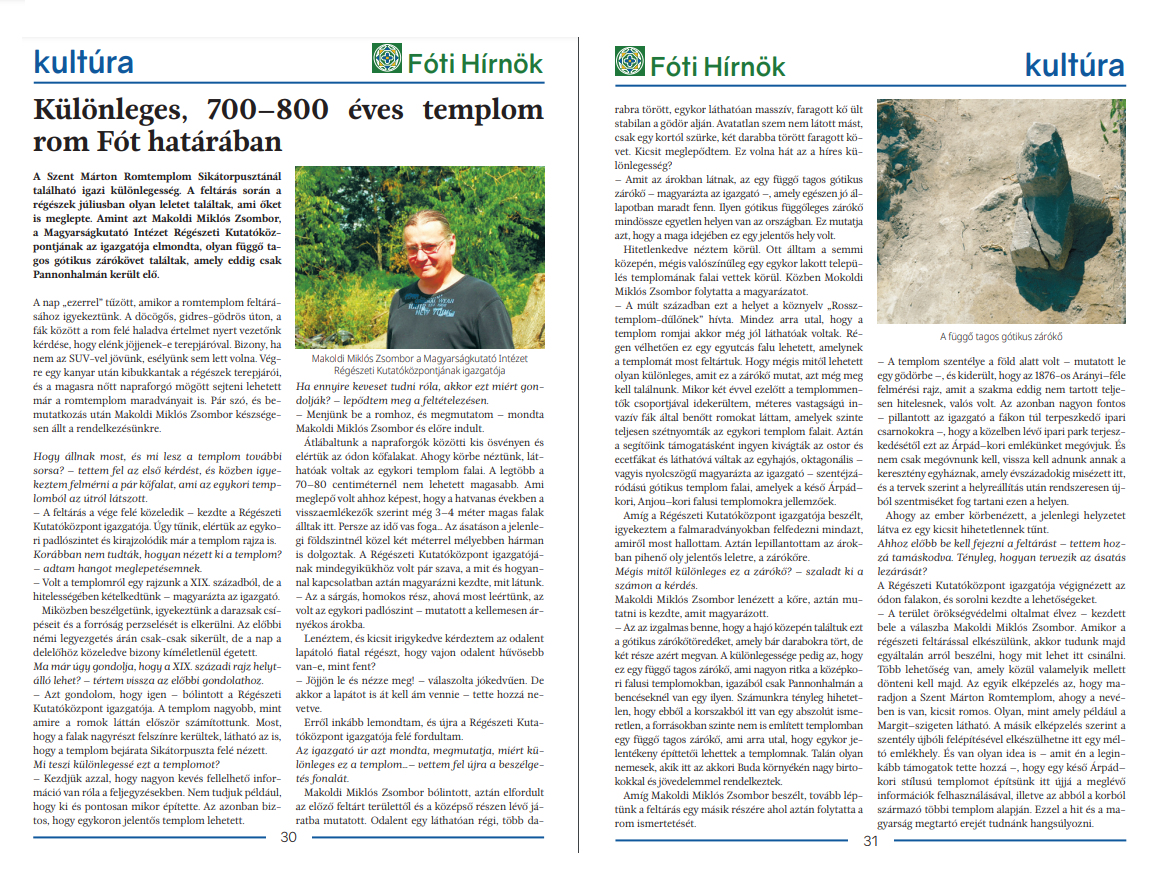
Celebrating the centenary of Hungarian-Turkish relations
Hungarian daily, Magyar Nemzet reported on the negotiations between Dr Gábor Horváth-Lugossy, Director General of the Institute of Hungarian Research, and Attila Pintér, Consul General in Istanbul, in preparation for the 2024 joint cultural year of the two countries.
“The preserving force of the faith and the Hungarian nation could be highlighted by the rebuilding of the late Árpád-era style church"
An interview with Miklós Makoldi, Director of the Research Centre for Archaeology of our Institute, on the archaeological excavation of the ruined Church of St. Martin was published in the Fóti Hírnök monthly.
"The ruined Church of St Martin at Sikátorpuszta is a real highlight. During the excavation in July, archaeologists found an artefact that surprised them. As Miklós Zsombor Makoldi, Director of the Research Centre for Archaeology at the Institute of Hungarian Research, explained, A GOTHIC CAPSTONE WITH A HANGING PENDANT WAS DISCOVERED, WHICH HAS SO FAR HAD ONLY BEEN FOUND IN PANNONHALMA.
- What have you achieved so far and what will be the future of the church?
- The excavation is nearing its end, it seems that we have reached the former floor level and the plan of the church is already emerging.
- Previously you didn't know what the church looked like?
- We had a drawing of the church from the 19th century, but we doubted its authenticity.
[...]
- Do you now believe that the drawing from the 19th century could be correct?
- Yes, we do: the church is bigger than we first expected when seeing the ruins. Now that most of the walls have been uncovered, you can also see that the entrance of the church faced Sikátorpuszta.
- What makes this church special?
- To begin with, there is very little information about it in the records. For example, we do not know who built it and exactly when. What is certain, however, is that it must have been an important church at some time.
[...]
- What you see in the trench is a Gothic capstone with a hanging member, - explained the director - which has survived in quite good condition. Such a Gothic vertical capstone exists only in one place in the country. It demonstrates that it was a significant site in its day.

- What makes this capstone so special?
- What's exciting is that we found this Gothic capstone fragment in the middle of the nave, which, although broken into pieces, still has two parts. And what makes it special is that it's a capstone with a hanging member, which is very rare in medieval village churches, in fact only the Benedictines in Pannonhalma have one. It is really incredible for us that a church from this period, which is absolutely unknown and barely mentioned in the sources, has a capstone with a pendent member, suggesting that the church may have had important builders once.
[...]
It is very important, nevertheless, to protect this Árpád-era monument from the expansion of the nearby industrial park.
AND WE MUST NOT ONLY PRESERVE IT, WE MUST GIVE IT BACK TO THE CHRISTIAN CHURCH THAT HELD MASSES HERE FOR CENTURIES AND PLANS TO HOLD REGULAR MASSES HERE AGAIN AFTER THE RESTORATION.
[...]
- How do you plan to complete the excavation?
- There are several options, and a decision will have to be made on one of them. The one I am most in favour of is to rebuild a late Árpád style church here using the existing information and based on other churches from that period. In this way we could emphasize the faith and the preserving strength of the Hungarian people."
The full interview is available on the website of Fóti Hírnök.


"The 1956 Revolution and War of Independence was also important because it exposed the Soviet and Communist ideology to the Western societies."
Our historian Zsuzsanna Borvendég gave a celebratory interview to Éva Harangozó in the daily newspaper Magyar Nemzet.
"Arad is the Hungarian Golgotha"
Zoltán Babucs, a military historian at the Institute of Hungarian Research, gave a presentation at the commemoration in Pozsony (today: Bratislava, Slovakia) on the imperial reprisals of 1849 and the martyrs of Arad. We quote from a summary by Éva Dunajszky on ma7.sk


Science and ethics link new intellectual force field
The Institute of Hungarian Research and the Batthyány Society of Professors signed a cooperation agreement. The Institute of Hungarian Research has thus gained a new field of intellectual power (...).
Sensational find arriving in Hungary
"... Eurasian civilisations adopted these techniques from the steppe peoples, the Scythians and the Huns" - An ancient and unique Hun sacrificial cauldron has been excavated by Hungarian and Mongolian archaeologists.


Sensational find arriving in Hungary
"... Eurasian civilisations adopted these techniques from the steppe peoples, the Scythians and the Huns" - An ancient and unique Hun sacrificial cauldron has been excavated by Hungarian and Mongolian archaeologists.

Genetic identification of the remains of Saint László and Béla III yields fantastic results
Gabriella Jeki's interview with Endre Neparáczki, Director of the Research Centre for Archaeogenetics of our Institute, about the identification of the remains of Hungarian rulers was published on the Origo.hu news site.

